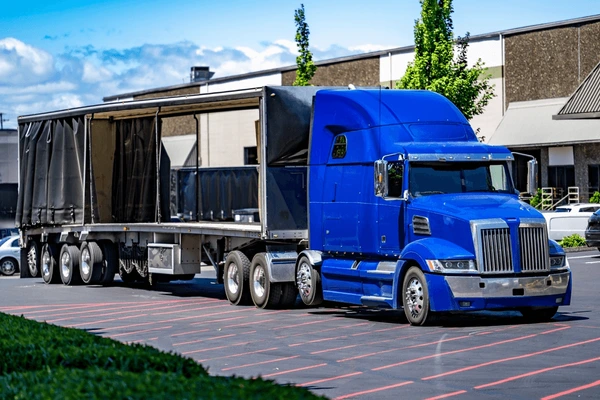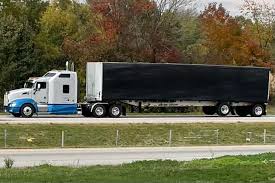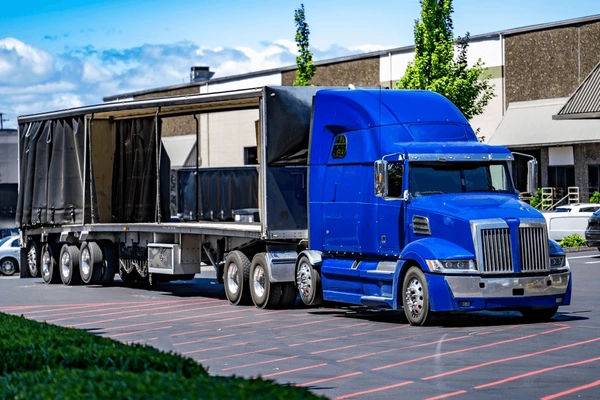A Conestoga trailer is a special kind of flatbed trailer used to transport goods. What makes it different from a regular flatbed trailer is its retractable curtain system. This system works like a cover that can be pulled back or closed, just like a curtain. The curtain is made from strong tarp material and is supported by a lightweight metal frame. This design allows for easy loading and unloading of cargo while still protecting it from the weather.
What Is a Conestoga Trailer?

A Conestoga trailer looks a lot like a flatbed trailer, but with one major difference—it has a movable tarp system that covers the cargo. You can think of it as a flatbed trailer with a flexible roof and walls. The curtain slides on a track and can be rolled to one end of the trailer. This gives workers full access to the trailer bed from the sides or from above.
Once the cargo is loaded, the curtain is pulled back into place and locked. This keeps the load safe from rain, snow, sun, dust, and road debris. The tarp is made from heavy-duty material that can withstand strong winds and rough weather. The frame is usually made from aluminum or steel, making it both strong and lightweight.
Why Use a Conestoga Trailer?
There are many good reasons to use a Conestoga trailer. It combines the advantages of a flatbed trailer and a dry van trailer. A flatbed is easy to load, but it leaves cargo exposed to the weather. A dry van protects the load but is harder to load, especially with large or odd-shaped items. A Conestoga gives you the best of both:
- Easy to Load and Unload: Since the curtain can slide open, forklifts and cranes can easily access the cargo from any side. This is perfect for heavy machinery, large metal parts, building materials, or other oversized items.
- Weather Protection: Just like a dry van trailer, a Conestoga trailer keeps cargo dry and clean. This is very important when hauling materials like steel, paper rolls, electronics, or furniture that can be damaged by moisture or dirt.
- Safe and Efficient: With a Conestoga, drivers don’t need to manually tie down a tarp over the cargo. This saves time and reduces the risk of injury. It also provides a more secure and professional appearance for the shipment.
Common Uses of Conestoga Trailers

Conestoga trailers are used in many industries because they are so versatile. Here are some common types of freight that are moved using Conestoga trailers:
- Steel Coils and Sheets: These need to stay dry and rust-free.
- Machinery and Equipment: These items are often large and heavy, and a Conestoga allows for easy loading by crane or forklift.
- Lumber and Building Materials: These products are bulky and need protection from the weather.
- Automotive Parts: These are sensitive to damage and need safe handling.
- Paper Rolls and Packaging Materials: These items must stay dry and clean.
How a Conestoga Trailer Works
The most important part of the Conestoga trailer is its sliding tarp system. This system is designed for speed, safety, and convenience. Here’s how it works:
- The tarp is mounted on a metal frame that slides on tracks along the trailer.
- When it’s time to load, the curtain is rolled or pulled to one end, exposing the flatbed.
- Cargo is loaded from the side, rear, or even from above using a forklift or crane.
- Once loading is done, the curtain is pulled back into place and locked at the ends.
- The cargo stays covered and secure during the entire trip.
This system protects the load just as well as a solid-sided trailer while allowing for easy loading like a flatbed.
Sizes and Types
Conestoga trailers come in different sizes, just like regular flatbeds. The most common sizes are:
- 48 feet long (standard size)
- 53 feet long (for larger loads)
There are also step deck Conestoga trailers, which have a lower deck. These are used for taller cargo that wouldn’t fit in a regular trailer due to height limits. The curtain system is custom-made to fit these different designs.
Benefits for Shippers and Drivers
Using a Conestoga trailer has many benefits for both the person shipping the goods and the driver transporting them.
For Shippers:
- Better protection for valuable or sensitive cargo
- Faster loading and unloading times
- More reliable delivery with less risk of weather damage
For Drivers:
- No need to climb and secure tarps by hand
- Less time spent at loading docks
- Reduced risk of injury and better working conditions
When Not to Use a Conestoga Trailer

Although Conestoga trailers are very useful, they are not always the best choice. They are more expensive to rent or operate than standard flatbeds. The curtain system adds weight to the trailer, so the total amount of cargo that can be carried is slightly reduced. Also, if you are moving freight that doesn’t need weather protection, a standard flatbed may be cheaper.
Conclusion
A Conestoga trailer is a smart solution for transporting cargo that needs both easy access and protection from the weather. It brings together the best parts of a flatbed and a dry van. While it may cost a bit more, the time saved and the safety benefits make it worth it for many types of shipments.
If your cargo is sensitive, oversized, or difficult to load into a dry van, a Conestoga trailer might be the perfect option. It’s all about keeping your freight safe, clean, and secure, no matter what the road or the weather has in store.




